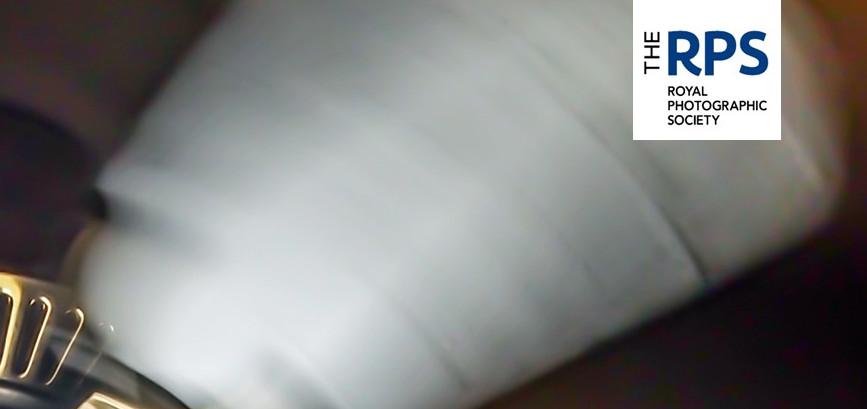

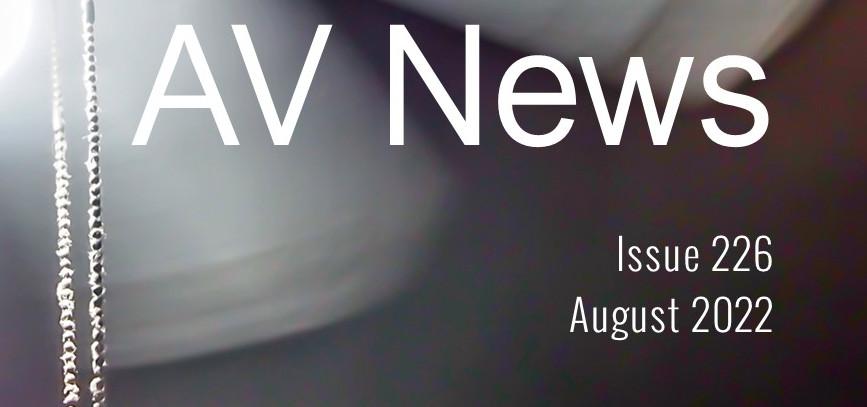








Page 1 | AV News 226 | August 2022
2 Chairman’s Chatter Edgar Gibbs 3 Editor’s Welcome Alastair Taylor 4 National AV Championships Alastair Taylor 8 Tribute to Graham Sergeant Howard Bagshaw 10 Audio Visual Lives Alastair Taylor 20 Getting Together: AV across the divide Jenny and Malcolm Gee 24 A Brilliant Day Jenny and Malcolm Gee 28 The Brits go to Garda Edgar Gibbs 32 APT 22 Alastair Taylor 38 Brown’s Lore Richard Brown 40 GNAVF New Horizons Roundup Various 51 Distinction Successes 54 Distinctions Advisory Day Edgar Gibbs 56 In My View – A Judge’s Perspective Andrew Gagg 59 Music :Licences Ian Bateman 62 DaVinci Resolve – Video Editor Overview Keith Scott 68 RPS AV Group Contacts 61 IPF 39th National AV Championships RPS Distinctions since 1971 Subscriptions are open to all at £22 per year including postage. Please contact: AV News Subscriptions Greendale, 9 Wood Lane, Hinstock Market Drayton, Shropshire, TF9 2TA Email: AVTreasurer@rps.org
Chairman Edgar Gibbs Secretary Keith Watson Treasurer Alastair Taylor Editor AV News Alastair Taylor magazine @avnews.org.uk Design Consultant Andrew N Gagg
In This Issue
AV Group
Chairman's Chatter
Edgar Gibbs FRPS, MPAGB, AV-AFIAP


Iam at the computer after, what I felt was a good day yesterday, at the Advisory Day in RPS House. See separate write up.
For those of you who are visitors to our website, which our web manager Sheila Haycox has made an excellent job of, you will �nd Past Programmes and Results for both the National AV Championship (NAVC) and for the International Audio Visual Festival (IAVF) Reading through as many old AV News magazines as I have, and seeking help from those people that have more copies together with Sheila Haycox and Richard Brown, we have got a table of past Chairs, Vice Chairs, Secretaries, Treasures, etc. It makes interesting reading as the older you are the more names you will know.
I was talking with Richard Tucker FRPS and the subject of early equipment arose and he was wondering if there was a museum within the RPS he could donate kit to. As there is no museum, I started to think how good it would be to create a virtual museum of AV equipment over the years. This could go on our website and become part of our history. Richard Tucker has a number of photographs of early AV equipment he would let the AV Group use, so this is something I will be putting to the Committee for approval. If you have any photographs of AV equipment you think could be displayed in the virtual museum, please send them to me at as large a resolution as you have. Anyway, as I write this, thoughts turn to the National Audio Visual Championship (NAVC) details of which are in this issue.
Talking about the NAVC I cannot let this article go without saying how shocked and saddened by news that Graham Sergeant FRPS passed away Tuesday 21st June 2022. He was a past winner of the NAVC, the International AV Festival, and had been a judge at both events. He was a lovely man, genuine, friendly, helpful and extremely talented with a super personality and always a lovely smile.
Page 2 | AV News 226 | August 2022
Alastair Taylor ARPS DPAGB/AV


Welcome, as always, to the latest edition of AV News. I hope you enjoy reading it and my thanks again to our various contributors. I don’t get a great deal of feedback but I would like to thank those of you who send the occasional email letting me know what you think. On balance, I think I have got AV News about right in terms of content and layout. You are the judge of that!
It has been great to see the return of a few physical events. Those of us who have attended have very much enjoyed viewing and hearing AVs as they are supposed to be presented. Heck we have missed it! I do urge those of you who have not yet emerged from your front room to do so. “Feel the fear and do it anyway” as the saying goes. The NAVC will be a great time to do this. That said, I do appreciate that there are those of you who have on-going health concerns and cannot join us. In some ways, the move to a mix of online and physical has left us with a more inclusive offer so people can get involved regardless of location and personal circumstances. Maybe that is one of the positive outcomes of the pandemic.
New in this Issue
Following a conversation between Edgar Gibbs and Richard Brown, we see the return (after 32 years) of Brown’s Lore. With someone as experienced as Richard writing his thoughts, I do hope you enjoy this feature and respond to his musings. Letters of response are always welcome.
I wanted to highlight the article “Getting Together AV across the divide” by Jenny and Malcolm Gee on their work with the RPS Documentary Group and the production of an AV called Aspects of East Anglia. I am convinced there are more opportunities for us to work with other RPS Groups . To that end, the RPS Travel Group have an event in October where there will be a ninety minute session on the use of AVs to showcase travel; something we do well.
Finally, in this digital age, where there are so many AV productions hosted on streaming platforms as well as a wide variety of other resources, I will be using QR codes to allow readers to link directly to these from a simple click or a scan on a mobile device. Scan the link here to see an example.

Page 3 | AV News 226 | August 2022 Editor’s Welcome
DPAGB/AV
We very much look forward to welcoming you back to the National Audio Visual Championship (NAVC). This year marks the 22nd NAVC and this will take place at Leeds Trinity University on Saturday 10th and Sunday 11th September 2022. The 22nd in 2022 has a nice ring about it doesn’t it.
In addition, there will be a Special NAVC AV Show on Friday 9th September. “The Magical Mystery Tour” is an evening of Beatles themed AVs from a selection of AV producers and featuring “The Fab Four”. This will include some fund raising activities in support of charity so do come along.
On the Sunday afternoon, the RPS President Simon Hill HonFRPS will be joining us to celebrate the winners. Simon has made AVs in the past and is looking forward to seeing some of our work.
On this page you will �nd all of the key information about the Championship including key calendar dates you need to remember.

We very much look forward to receiving your entries and seeing you in Leeds in September. After a three year wait, we hope that you are as excited as us at the prospect of a live AV event where we will see and hear AV Productions as they are supposed to be seen and heard.
Calendar
Entries can be received from: Monday 18th July 2022
Closing date for entries: Sunday 21st August 2022 (midnight)
Book to attend the event from: Monday 18th July 2022
Closing date for event bookings: Sunday 4th September 2022 (midnight)
Dates of NAVC: Saturday 10th and Sunday 11th
September 2022
Results emailed and published: W/C 12th September 2022
If you have any questions, please email rpsavgroup@gmail.com
Page 4 | AV News 226 | August 2022
Chair of NAVC 2022 - Alastair Taylor ARPS





Page 5 | AV News 226 | August 2022
Entering the Competition
Please visit the NAVC pages at: https://rps.org/groups/audio-visual/navc/ or click on the following QR Codes






NAVC Website Entry Form (PDF) Entry Form (Word)
Attending the NAVC
Booking Form (PDF)
Booking Form (Word) Championship Rules
Medals
1st - RPS Gold Medal
2nd - RPS Silver Medal
3rd - RPS Bronze Medal
Photo Harmony – Specialist Interest Group (SIG) Medal
Judges Choice – Specialist Interest Group (SIG) Medal
Judges Choice – Specialist Interest Group (SIG) Medal
Pollock Medal for the Best New Entrant
Ribbons
Highly Commended – 3 awarded RPS Ribbons
Commended – 3 awarded – RPS Ribbons
Judges’ Mention – 3 Certi�cates
Audience Vote
The Best New Entrant is de�ned as someone who has never won an award in a National or International AV Competition, and does not hold an AV distinction from the RPS, PAGB, FIAP, IPF or APS.
Page 6 | AV News 226 | August 2022
The Judges
Ian Bateman FRPS MPAGB AV- AFIAP APAGB
Ian retired to Exmouth in 2015, and in recent years has been both Chairman of Exmouth Photo Group and President of the Western Counties Photographic Federation. He started making AV sequences in the mid-1980s, initially with slide/tape before pioneering digital methods in the late 1990s. In 2002 he was the �rst person to be awarded a Fellowship in AV with a digitally-projected panel. He has lectured and judged AV events all over the country and abroad, and was Chairman of the RPS International AV Festival from 2009 to 2014. He is currently on the RPS Film, Digital and Multimedia Panel as the AV Specialist.
Sheila Haycox ARPS MPAGB/AV EFIAP

Photography has been Sheila’s main hobby since 1986. She belong to a couple of clubs in Devon plus various AV Groups. She is a past Chairman and also past Secretary of Exmouth Photo Group and now their webmaster. Over the years she has gained distinctions in both prints and AVs. She has two ARPS Distinctions, one in prints and one in AV and was very pleased to be awarded an MPAGB/AV in 2016 and now �nd that she is doing more and more in the AV world. She is pleased to have gained several awards with some of her AVs. Sheila thoroughly enjoys making AV sequences and doing presentations to clubs. She likes to offer something for everyone, which could be documentaries, humour, photo harmony and nature.
Alan Tyrer ARPS DPAGB/AV

Alan has had success at many regional, national and international competitions. He has also enjoyed judging at all levels and giving AV presentations to interested groups. He has been successful in achieving distinction awards from the RPS, PAGB and FIAP. He also served as Secretary of the RPS AV Group for six years. He believes that photography and AV should be valued as an art form and that the job of a judge is to encourage everyone to develop their best work. He thinks that AV is a great hobby and an entertaining spectacle.

Page 7 | AV News 226 | August 2022
Graham Sergeant FRPS (1937-2022)
It is with very great sadness that I must let you know that Graham Sergeant FRPS passed away recently. Graham had been unwell for a little while and sadly suffered a heart attack.
He had been a teacher for 35 years, lecturing in sociology at Southgate College. But at the same time, he pursued his interest in photography and in 16mm �lm making.


He joined the RPS on retirement and was soon awarded two Fellowships, both in contemporary photography. Later he was to use the subject matter, and these award-winning photographs, to produce two award winning AVs.
To me most memorably, he produced “Beeswing”, a stunning AV about the life, struggles and death of Lise. It uses his gritty monochrome images, and the story is told with so much compassion.
 A Tribute from Howard Bagshaw ARPS,MPAGB
Image of Lise, from Beeswing
A Tribute from Howard Bagshaw ARPS,MPAGB
Image of Lise, from Beeswing
Pictured left: Graham receiving the IAVF award from the RPS President

With Beeswing, Graham won both the RPS Nationals (2017), the RPS Internationals (2016), as well as the Trophée de Paris (2016).
A second notable AV, The Dance Goes On... told the incredible story of Elizabeth Twistington Higgins MBE. She was a ballerina, who caught polio aged 30, and thereafter spend half her days in an iron lung but continued to teach and support ballet dancing.

Recognising Graham’s long interest in �lm and his outstanding contemporary photography, he was invited by the RPS to be a panel member of three distinction panels, Contemporary, Applied and Multimedia & Narrative.

Together with a small group of AV enthusiasts from Sussex (who he often referred to as the ‘Southern Marauders’), he regularly attended AV festivals. He was also invited to speak to photographic groups and to judge AV competitions, most notably judging both the RPS Nationals and RPS Internationals (2021).
Graham will be very sadly missed. Those who knew him will remember him as a true gentleman, kind, always courteous, thoughtful, yet challenging in his ideas. Our sympathies go to his family and friends.
Image from The Dance Goes On
An interview with Keith Leedham FRPS
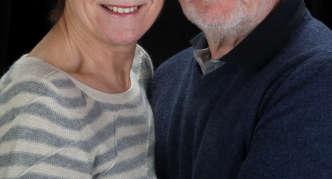
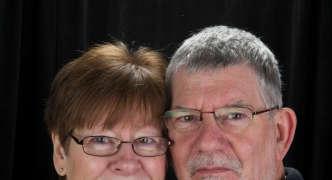
 EFIAP FIAPF
EFIAP FIAPF





There are few people who can say that their lifelong interest in photography has gained them friends all over the world as well as being something from which they earned a living. Keith Leedham is one of those people. He was keen to point out that so much of this was in the company of Marilyn.
I thought I knew Keith, but clearly I don’t. In his own words, “I have served on The RPS International AV Festival committee for 28 years and I am still a member of that committee. I have been attending and entering national and international AV festivals because I am quite competitive and enjoy meeting like-minded people. I �nd AV a good way to express myself and have learnt so much by researching my own and watching other people’s sequences. In order to try and give something back to my hobby I became chairman of the RPS AV Group committee for �ve years and also have been a member of the RPS distinctions panel.
Page 10 | AV News 226 | August 2022
I am interested in close up and nature photography and many of my sequences are on that subject. I spend a lot of time watching and photographing insects. I love music and my love of music helps me in the making of my sequences.”
Keith started in photography when he was a teenager when his father bought him a camera for his birthday. He and his dad were members of Leyton Camera Club in the East end of London. Keith’s camera, a Rollei�ex Twin Lense Re�ex (a TLR, remember those!). When it went wrong, he took it to the original importers, a company called R F Hunter who were able to successfully repair it. The original camera costs £37 and 10 shillings. Keith still owns it. (Right , Keith aged around 16)
When Keith went to pick up the camera, he asked if there might be a job for an apprentice camera repairer and that is where he started working under the stewardship of a German factory engineer who showed him all the ropes of camera repair. “Ever since then my profession has been repairing all types of photographic equipment until I retired at sixty �ve” Keith adds.
Keith had various jobs such as working for an optical company making lenses for glasses and then for the importers of Fuji, Zenith and Canon cameras. After a range of jobs, he became a freelance camera repairer, a job he still does today.


We joked about the need to have good eyesight when conducting work of this nature and Keith admitted that he is similar to the guy on the BBC Repair Shop who wears two pairs of glasses. He has written into the TV programme producers telling them that if they ever they need a camera repair expert, then he is their man. They haven't got back to him yet, but watch this space!
At the same time as repairing cameras, Keith was an avid amateur photographer. He gained his RPS Licentiateship and Associate distinctions in black and white print photography back in 1977 when he was a member of Rayleigh Camera Club. Keith commented: “I've got hundreds of Black and White Prints from my RPS panel, all nicely stored away, that never see the light of day. That is the power of audio visual as it is a great medium for showing off your work and adding to the story”
Page 11 | AV News 226 | August 2022
Audio Visual Lives continued

It was at Ingatestone camera club that Keith �rst came across AV. It was a show by Mike Woolnough. “I wanted a piece of that action” Keith added, “the challenge then was that you had to have your own equipment. My �rst effort was on one projector it was about honey bees, another interest of mine”. We joked that it is ironic that in the recent Jurassic Coast AV competition Keith won the bronze medal for an AV with a similar theme.
Keith went on to gain his RPS fellowship in 1987 – his submission included an AV on the subject of honey bees – funny that! He gained his FIAPF in 1995 and EFIAP in 1997.
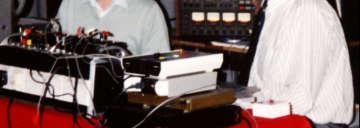
Keith talks about the late nineteen eighties being a “golden era” in the world of AV. There were so many helpful people. Keith recalls attending an regular RPS AV Day in Bexley Heath organised by Tom Burns where he met the great Norman Veale and also Ian Lang, both of whom became great friends. Keith added that Norman Veale collection of AV’s is held by a friend of his from Essex, Roger Stevens, and how great it would be to give access to some of these �ne AV sequences to show people how it should be done. We talked about the other wonderful names from the AV community, people like George and Doreen Pollock, Richard Brown, Keith Brown, Pat Whitehouse, Ron Davies and Clive Atkins.
Keith recalls AV sequences like Millstone Grit by Geoff Holmes and the collaboration between Colin Balls and Peter Coles which were so ground breaking at the time and still hold up well when viewed by the modern audience. These were good times for the AV community and we comment how sad it is that so many of these people have gone before but how much we gained from their friendship and the work which they produced.
Left Top: Keith with Mike Woolnough

Left Bottom: Keith's AV setup at home
Right top: Keith, Richard Brown & Colin Balls
Right Middle: Keith, and the RPS President with Peter Coles and Clive Atkins
Right Bottom: Linda and Ron Davies with Keith at the East Anglian AV Competition
Page 12 | AV News 226 | August 2022
Keith is very keen to point out that one of his most supportive and best critics was his late wife Marilyn. He would ask her what she thought about his work and she was a massive help and a great support. She was very loyal and instrumental in so many aspects of AV where she was a member of various committees. Keith comments that he wouldn't be where he is without her support. Keith adds that during the past 18 months the love and support he has received from so many people in the AV community is what has kept him going and through this article he wants to express his thanks and appreciation. He is looking forward to the return of physical AV events where he can thank people in person.



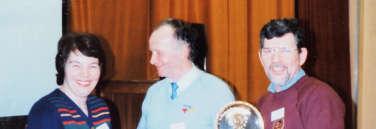
We go on to talk about Keith’s artistic in�uence.
Keith thinks that many AV workers are basically frustrated �lm producers who are looking to create a seamless visual and soundscape. We talk about the concept of screenplay and cite great �lm producers like David Lean, Danny Boyle or those who made those Pathe Newsreels. We agree that there is much to be learned from these people and comment that perhaps that is something for another article in AV News.
Keith reminds me of the need to write at the top of the light box a question as to why are you doing it, why are you making it and what you want to achieve. He says that his aim is to create an emotion, be that laughter, fear or tears, anything but boredom! Too many AVs have that tendency to be a little boring or a little too long but when it works well it is a magical medium and can be brilliant. Perhaps the thing to write at the top of the light box is “do not be boring”. He thinks that those people who comment that “they make a sequence for themselves and if other people like it that's a bonus” maybe need to think beyond that and think about the emotions they are trying to express. (AV News Editor take note!)

Page 13 | AV News 226 | August 2022
Audio Visual Lives continued
Keith thinks that one of the masters of creating an AV which carries emotion and interest is Clive Atkins, In Clive’s professional career, he was a sound engineer for Central Television and he made some great AV sequences which always had something of a sting in the tail or told us story which left a question behind.
Keith comments: Clive’s approach was to make the soundtrack for the AV before taking the pictures and this is an approach which I adopt to this day” He will record a soundtrack leaving suitable gaps for the images to help tell the story maybe going back to tweak it if needed but that is the method he still adopts, and with some great success.
We go on to talk about some of Keith’s successful AV productions.
“The Inn on the Pass is a sequence about Ghosts. My approach was to build in some innuendo, allowing the music to build up the tension make some hints at the theme of the AV without actually telling the story” Keith talks about the need for attention to detail so it’s a case of polish, polish and polish again.
Two other AV Productions which have been very successful for Keith are For the Sake of Example and The Grey Ghost both of which adopt this approach to AV making.
Keith learned this approach from a sequence called Monsieur Maurice by Norman Veale. This is about a French impressionist artist. It had a very clever section where he was telling the story of the artist and setting the scene and at one moment he says the words “and she stayed the night” whilst showing an image of some lights switching off in an upstairs bedroom window. “It was very effective and a great lesson in less equals more” adds Keith. He feels that really good scene setting is a very clever hook which draws the audience in and is something which Keith tries to do in his AV productions. “For example, it is amazing the impact of showing a few cobble streets whilst playing the sound of a horses and carriage.”
Keith talks about other AV artists who adopt this approach and cites Martin Fry. He believes that he is on the same wavelength as Martin and talks about Martins AV A Cotswold Lad which was a real in�uence on him where the story was told through the opening sequences without a word being said but was very effective in getting the message over. In another example from Norman Veale Song of the Merrymen. “He told you where it was and when it was with out saying a single word” adds Keith
Pictured right: Images form The Inn on the Pass
Page 14 | AV News 226 | August 2022
“The Inn on the Pass is a sequence about Ghosts. My approach was to build in some innuendo, allowing the music to build up the tension make some hints at the theme of the AV without actually telling the story”
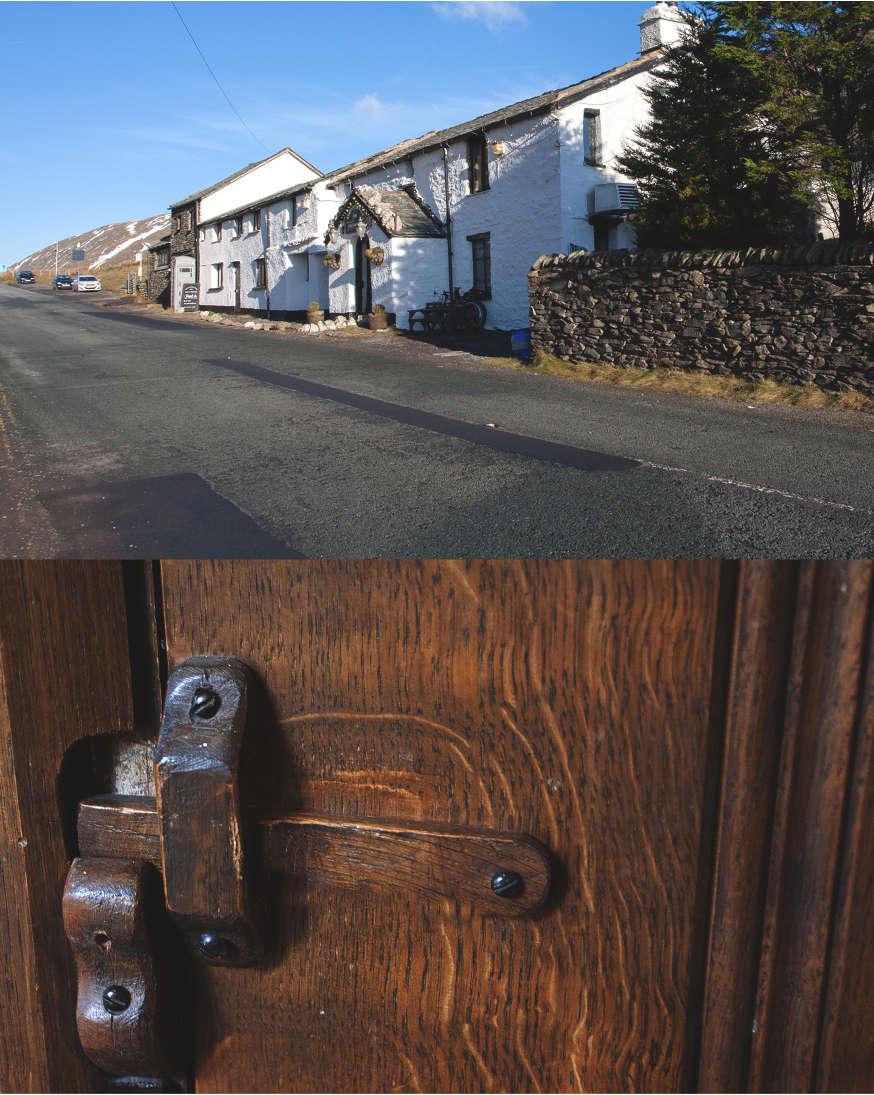
Page 15 | AV News 226 | August 2022
Our conclusion is that too many AV productions, and particularly those with a documentary theme will often say too much. They will tell the audience all about the subject at the same time as showing pictures of the same subject. That is not needed when an alternative approach can be used. If there is a takeaway message and lesson for others it is to adopt the approach of letting the images tell the story and draw the audience in.

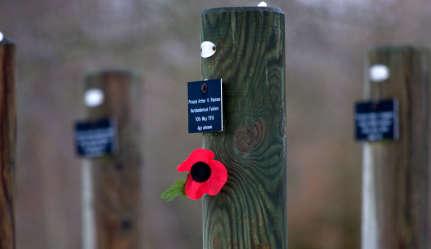

Keith thinks that the old school people like himself, Richard Brown and Martin Fry should be worried about new AV workers coming along with new ideas and “knocking them off the perch” but there are not enough of these. There are some great storytellers and for example the work of Judith Kimber is one which Keith respects. We also talk about the growth of Italian AV workers and what a great job they do at telling a story without words, often a story which creates great emotion. We both agree that it has been wonderful to see the rise of Italian AV workers over the last few years.

Audio Visual Lives continued …
Images from For The Sake of Example
One side of AV production which Keith believes is under represented is the interpretation of a song.
“There is not enough of this going on” comments Keith, “the theory is that the song sets the mood and the pictures tell the story”
Keith shared with me a couple of his examples of his work which I hadn’t seen before. These are A Soldier's Farewell and The Lost Years both of which are singing about a certain mood. We also talk about the best AV workers authors being those who give something of themselves, something of their own emotion, something of their own background. We agree that not everyone is capable of doing that and one has to have deep emotional intelligence to be able to pull that off but that said, some people do that very very well and very effectively.
At the end we go on to talk about the current state of play. Keith has had a dif�cult 18 months but is now starting to make AV productions again. He says that he can't stress enough the contribution of the AV community in helping him to come back to the world of AV. We talk about the in�uence of Marilyn on Keith’s life how she taught him about Scottish country dancing. We joke about country dancing versus AV it was only when Marilyn became President of the Caledonian society that Keith wore a kilt for the �rst time (Pictured right) . Until then he had refused to do such a thing.
Pictured Below: Winning the RPS International in 2012


For The Sake of Example competition history so far:
First Places
RPS International AV Festival 2012
Great Northern International Festival 2012
International de l’Image Epinal France 2012
National Memorial Arboretum AV Competition 2012
East Anglin AV Competition 2012
Second
Adelaide AVFest 2013
Third
National AV Championships 2015

Audia International Festival Romania 2015

Page 17 | AV News 226 | August 2022
Above: Keith and Marilyn at a a classic bike show.


Left: Setting up for the RPS International AV Festival
Below: At the RPS International AV Festival with Marilyn, Bryan Jeffs, Sylvia & Dick Williams
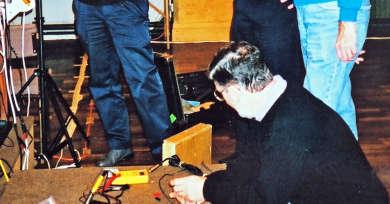
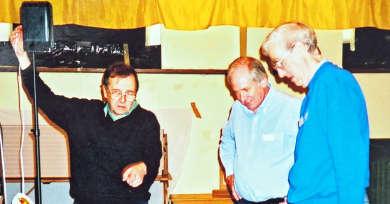


Below Right: With the RPS President at the International AV festival in 2017.
All pictures courtesy Keith Leedham

Audio Visual Lives continued …
We talk about our hopes and wishes for AV he said that AV groups have struggled particularly during the COVID pandemic but on the other hand the use of online platforms has been a great help, that said he can't wait to meet with people and see AVs on the big screen again. On that matter we would all agree I am sure.
Keith has enjoyed great involvement with the RPS National Audio Visual Championship. There are few who can demonstrate a CV as good as this.
1989 Best Registration Happy Christmas Darling
1991 Second Place One Volume Price 3/-

1993 Photo Technique Award A Soldiers farewell
1995 Member of the Judges / jury
1997 The Lost Years & The Blitz of London
1999 12th Position Melanie’s Visit
2001 First Place Gold Medal Still Waters Run Deep
2003 Chairman of the Jury
2005 Back Then & Go
2007 First Place Gold Medal Slainte Mhath
2009 Show Me Heaven & Michael
2011 In Assynt & I Believe
2013 Chairman of the Jury
2015 3rd Place & Audience Vote For The Sake of Example
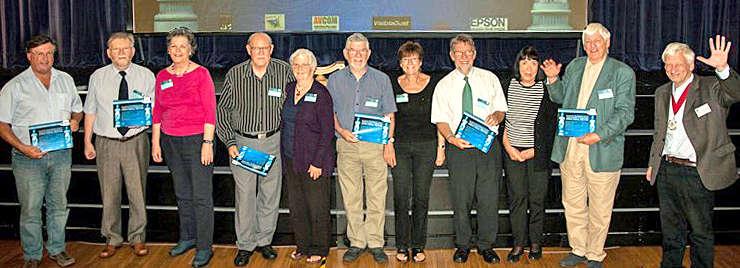
2017 HC and Audience Vote The Grey Ghost
Thanks Keith for your great contribution.
Getting Together
AV across the divide
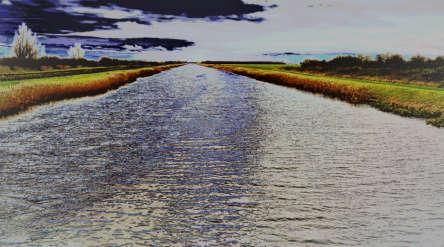 Jenny Gee LRPS, DPAGB/AV and Malcolm Gee ARPS, DPAGB/AV
Jenny Gee LRPS, DPAGB/AV and Malcolm Gee ARPS, DPAGB/AV
In a recent edition of AV News (Issue 224, p4, December 2021), the editor mentioned that it would be nice to see some collaboration and cooperation between the RPS AV Group and other RPS Special Interest Groups. Well, it’s already happening, and we thought readers might like to learn about a recent project that we’ve been involved in.
A few years ago we joined the East Anglia Branch of the RPS Documentary Group. At a meeting in autumn 2021, ways of showcasing the work of Group members was discussed, and the production of an audio-visual (AV) sequence was suggested. This was enthusiastically taken on board, resulting in an AV project entitled Aspects of East Anglia.
The intention was to include a wide range of documentary photographs, showing different aspects of one of the larger RPS regions in the UK. With our experience in AV production, we were quickly approached by the chairman, Malcolm English, and agreed to take on the task.



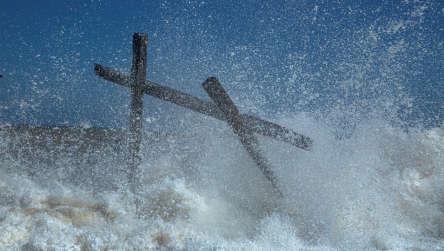
Page 20 | AV News 226 | August 2022
With the project now up and running, we discussed the overall format and logistics with the chairman. Having agreed the basics, he then allowed us to use our discretion and gave us free reign in all aspects of the production. The next step was to produce guidance notes and a timetable for Group members. At this stage we had no idea of what sort of images, or how many authors, would be involved, so we set a preliminary limit of a maximum of 10 images each. Authors were able to choose a theme within the overall title, and submit images to represent it. Unlike a book, individual images would not have titles, but authors would be credited at the start of each individual theme.
It was decided to make the sequence in the traditional landscape format, with an aspect ratio of 16:9 (widescreen). To ensure a ‘professional’ appearance, and to ease production, image format had to be carefully controlled, hence the guidance notes on image submission. Members were invited to send us their contributions over a three week window in March this year, using the WeTransfer �le sharing facility. Despite a few problems, by the end of the month we had 108 images (cropped and titled in the correct format) from 10 individual photographers and one couple (ourselves), covering 11 themes.
Images


Image Below: Tim Munsey
 Left, top to bottom: Richard Jefferies, Des King, Alan Horn, David Portwain, David Collins.
Left, top to bottom: Richard Jefferies, Des King, Alan Horn, David Portwain, David Collins.
Getting Together : AV across the divide continued ...


From the outset, it was envisaged that the AV could be distributed to other branches of the RPS Documentary Group and to photographic clubs and societies, and be posted online. Consequently, to avoid any copyright issues, the music used needed to be royalty free, and once we had the images, the search began. In our music library we have an AKM Music CD; part of a prize at a recent Great Northern AV Festival. Once we had looked at all the images, we realised that this CD, that we were licensed to use, had some music that was potentially very useful, so Jenny ripped the contents (40 minutes in 16 tracks) into our computer.
The challenge was then to produce a soundtrack with 11 segments of roughly equal length, to match the images and moods of the individual themes, and to accompany the introductory and concluding titles. Fifteen clips from 9 of the tracks were selected, and mixed using Adobe Audition sound processing software, to produce the elements of a soundtrack. These were then blended into a continuous piece of music, bearing in mind a pleasing order for the themes, and links between them. This process eventually resulted in a useable soundtrack, just under 14 minutes in length.
Although it’s length was greater than originally planned, the division of the AV into themes, meant that it would be possible to incorporate all the images submitted, without the sequence seeming over long. Having made this decision, the images and soundtrack were imported into PTE AV Studio Pro, and the process of matching images to music, with appropriate dissolves, began.
After many hours and numerous tweaks to the soundtrack, image order and transitions, we were happy with the result, and the AV was published as an mp4 �le, to make it universally compatible for viewing. We sent it to the chairman, and sat back and awaited his reaction ….!
Image: Kevin Gotts
To our delight, he was very pleased with the result. The AV was immediately distributed to all the Group members, with extremely positive feedback, and wider circulation is now in progress.


Projects such as this can have a reciprocal positive effect. On one hand, they provide an opportunity for more photographers to see their images presented in a very different way, perhaps even stimulating an interest in AV production. On the other hand they could potentially provide projects for existing AV workers, and stimulate collaboration with other RPS Special Interest Groups. Joining the local branch of the RPS Documentary Group certainly prompted our enthusiastic response to the idea of being involved in a different sort of AV project. It has proved to be quite a challenge, but a very enjoyable one, and has allowed us to give Documentary Group members a taste of what audio visual is all about.

Images Right, top to bottom: John Walker, Malcolm English, Malcolm & Jenny Gee, David Baxter
View Aspects of East Anglia at:






Page 23 | AV News 226 | August 2022
A Brilliant Day!
Jenny Gee LRPS, DPAGB/AV and Malcolm Gee ARPS, DPAGB/AV

The plan was for this Great Yorkshire AV Day to be somewhat of a reunion, but once again Covid-19 intervened, and the organisers had to revert to holding the event on Zoom. For us, down in Norfolk, and a long way from Leeds, this was more than a bonus. We jumped at the opportunity to join the online ‘audience’ on Saturday 2nd April, thanks to Bryan Stubbs and his team from the Leeds AV Group, who organised everything and hosted the day. We all duly logged in – on time of course, as Keith Scott was there with his trusty stopwatch, keeping everything ‘ticking’ along for the morning session. The day proved popular with a very consistent online audience size in the mid �fties.

As moderator, Keith ran the �rst session like clockwork, and we were treated to 13 Attendee sequences over the next two and a half hours, with a short break for coffee about half way. At the start he informed us that precisely 4 minutes and 8 seconds would be allowed between AV’s for introductory remarks by the author and comments afterwards!

Page 24 | AV News 226 | August 2022
There were some really great contributions. One that made a particular impression on us was a sequence by Ron Henry, entitled Second Class Prize that started the day. This contained some excellent animation to illustrate the writing and sending of a post card. There might have been a few too many postcards, but that could easily be �xed. Another was Finding Uncle Fred by Tim Harvey, shown at the end of the morning. A good story, so beautifully told and illustrated, and not too long – a very nice piece of work. Once or twice we thought that it was going to stray off the main point, but the very clever script kept us on track, and held our attention right to the end.
The overall standard was good, and subject matter broad ranging. In Uncle Fred (yes, another Fred!) we discovered more about Sheila Haycox’ extended (�ctional) family. With Where the Rivers End, Harry and Kath Gilbert gave us a real �avour of the organised chaos in Bangladesh’s capital city Dhaka, and the contrasts with life in the surrounding countryside. An interesting AV, by John Harbron, certainly encouraged viewers to visit the Raby estate in County Durham, although the sequence could perhaps be further improved by shortening it a little. Generally speaking, in AV the shorter the better. Jim Waddington showed a piece about the Dorset village of Tyneham, requisitioned by the Army in WW2, and although we had seen a couple of other versions, we found this one pleasingly different. Dave Thompson’s Samdalorian turned out to be a quickly constructed AV, done as a Lockdown project to entertain his grandson. The audience agreed that the 9 year old had done a terri�c job narrating the animation. It’s amazing what’s noticed. For example one audience member spotted a slight con�ict between the tone of bagpipes, in Jane McIlroy’s Flower of Scotland and the voiceover, which again could be �xed relatively easily in sound processing software. This sequence also prompted a comment on bringing AVs to a satisfying conclusion, and offered a suggestion in this particular case.
Several authors actively sought comments and feedback in their introductory remarks. Some had re-made a sequence to get feedback on the changes, others wanted reactions to ‘work in progress’, so we saw quite a lot of new AVs. Audience participation was excellent throughout the morning session, and constructive criticism was given, raising a number of useful points where improvements could be made. For example, the importance of a concise script, with not too many facts, delivered with feeling and ‘breathing spaces’ between pieces of information. The possibility of shortening a sequence was also mentioned several times. Appropriateness of music, and using something not instantly recognisable was advised to avoid con�icts in the atmosphere created. This was particularly the case in Dave Walker’s The other Florida, and a suggestion was made to drop the music and just use the wildlife sounds as a soundtrack to underpin the mood.

Page 25 | AV News 226 | August 2022
A Brilliant Day continued ...
One sequence in particular, Harmony by Alan Tyrer, provoked a lengthy and controversial discussion about what actually constitutes a good photo harmony AV. In the end it was agreed that there is probably the need for a new, better understood de�nition. New AV workers often start with just images and music, before expanding to a full soundtrack with added voice over and sound effects, and it was agreed that it would be a shame to discourage them by removing the category in competitions.
After the lunch break, it was ‘The Jill and John Show’! In his introduction, Bryan reminded the audience that this was in fact their second appearance at a Great Yorkshire AV Day, and that they had indeed now joined an exclusive club of speakers invited again! Jill Bunting and John Smith’s �rst visit was back in November 2008, at the �rst meeting organised by Bryan, and held in Bradford. He said that Jill and John are known to most of the AV community, not only for their unsel�sh willingness to offer help with countless aspects of PTE software, but also for keeping us all going during the pandemicupdating us all on the latest news via several websites, and hosting a wealth of events on Zoom with great expertise. Bryan pointed out that, despite their extremely busy schedule, they had still found time to accept the invitation to be the speakers for the afternoon, for which he thanked them very much and welcomed them.
First up was Jill. She illustrated her talk with sequences spanning a number of years, including one of course starring Little Ted and his friends! She explained how early versions of Pictures to Exe (PTE) had very basic dissolve features, no animation and just the facility to add a music track: A stark contrast to the suite of visual effects, and sound editing available within the program today. Using her AVs, she described why and how they had been made, and expanded on some of the techniques used to achieve desired effects. She talked about the role of music in creating different moods, and gave a quick overview on the basics of sound editing in the latest version of PTE AV Studio. She emphasized the importance of a ‘natural delivery’ in commentaries, with speech being well spaced and placed sympathetically within any music in the soundtrack. Finally she showed ‘The Colour Thief’, her most successful sequence to date, and one showcasing a wide range of animation effects.
After a short break, John took over, and gave us a highly entertaining ‘tutorial’ on animation, demonstrating how he achieved some of the amazing effects in the introductory sequences, made for both national and international competitions.
Page 26 | AV News 226 | August 2022
One recurrent theme in these sequences is the novel ways in which the judges travel to a particular event. He showed us how a route can be traced on a map, and embellished with animated overlays. John has a wicked and very inventive sense of humour! He obviously goes to great lengths and takes great pride in doing a good job, and has enormous ‘stickability’ when trying to get an effect just right. He �nished by showing one of his most successful AVs, The Messiah (a spoof on Handel’s Hallelujah Chorus). There must have been households all over the country, and further a�eld, left chuckling at the many very inventive and clever ideas he comes up with. It was very obvious that both Jill and John place great importance in attention to detail, often requiring enormous patience, in the quest to make a sequence both informative, convincing and enjoyable.


We thoroughly enjoyed the whole day. Everything ran smoothly, and there was a good atmosphere. The only downside was that we all missed out on the legendary sandwiches provided by Betty and her team – the only bene�ciary on this occasion being Tony Collinson, who was of course at home for lunch with Betty. All in all, it was ‘A Grand Day Out’, as Wallace and Gromit would say, even though it had to be on Zoom!

Page 27 | AV News 226 | August 2022
The Brits go to Garda
Linda and Edgar Gibbs FRPS, MPAGB, AV-AFIAP
After two years of AV events being held on line, the time seemed right to venture to the 10th Città di Garda International AV Competition 2022. Robert Albright had been invited to be on the Jury, and we followed his lead and booked a package with TUI, �ying to Verona from Birmingham Airport. We were joined by Richard Brown and Dave Cooke. Carole & Howard Bagshaw, Bev & Alan Tyrer, plus Malcolm Imhoff & José Current decided to drive to Italy.
As the date for our trip got nearer, we watched the news and became very aware of the delays at UK airports. Was this due to the travel companies laying off staff due to Covid, did no-one want to work at airports anymore or was it as a result of Brexit? We will never know. The UK Transport Secretary, Grant Shapps did tell us to only to take carry on cases though, but Linda was having none of that!
We stayed the night (well part of it) at Birmingham Airport and made our way to departures at the advised time of 03:30, on the Wednesday morning. Yes it was very early! We checked-in our luggage and made our way through security. It probably took over an hour snaking through the crowd control barriers to get air side.
However, at that time little did we know that days earlier the Italian Air Traf�c Controllers had announced they would be holding a strike on the day of our �ight. Did TUI tell us? You've guessed it - the email arrived just after we'd passed through security. Our plane was now scheduled to take off at 23:45 rather than 06:40.
We waited and waited and �nally boarded the plane after midnight. Miraculously, there was a 150 mph tailwind, so we arrived in Verona Airport earlier than expected.
The transfer coach dropped us off outside our hotel in the early hours of Thursday morning at 03:00, UK time. Ringing the bell at the locked gate, the Night Porter let us in. We had checked out of our hotel at Birmingham Airport on Wednesday morning at 03:00 and with no real sleep during the wait for our delayed �ight, we eventually got to bed over 24 hours later.
Page 28 | AV News 226 | August 2022
Photos courtesy: Howard Bagshaw, Edgar Gibbs and Malcolm Imhoff.
Whilst waiting for our �ight at Birmingham Airport we received an email with the news that Lorenzo De Francesco, the Jury Chair and Lead Organiser had tested positive for Covid, but the Festival would go ahead. Alan had a medical issue, when he was in France with the family, which meant he and Bev would not be joining us. Howard and Carole were already at the hotel and Malcolm and José were camping not far away. Thursday was a recovery day in more ways than one, but on Friday we had a day out by ferry to Gardone on the opposite side of the lake.
After our meal that evening we went to the �rst session of the Competition. We did miss Lorenzo's genial personality. He has always been Italy's friendly smiling face, and very welcoming with his own style of presenting the AVs. The Theatre at the Sala Congressi di Garda was very comfortable and Edgar was pleased that he was able to help Fulvio Merlak (who was not only a Jury member, but literally now running the show in Lorenzo's absence), get the sound to work.
All of the Brits took our seats, with Robert sitting separately. Disappointingly, we were not joined by any other audience members. An introductory AV highlighting the winners and guest judges over the last 10 years was a welcome start to the Competition. Fulvio then whizzed through the AVs with hardly 5 seconds between each one. Unfortunately, this meant that there was no opportunity to make notes or get some translation done to understand the titles and some of the content.

The Brits go to Garda continued ...

Saturday morning came and we assembled again for the remaining four sessions. Still missing Lorenzo, Edgar stepped in and went to the front of the theatre and said "Good morning everyone, and welcome to the Garda International AV Competition. Unfortunately, Lorenzo cannot be with us due to testing positive for Covid, but he does send his best wishes". Edgar turned to Fulvio who pressed the button and we proceeded to watch the AVs.
The end of the session arrived and again Edgar addressed the audience with "It's the coffee break now - be back promptly at 11:30". No doubt being the Director of the RPS International AV Festival he felt it was his duty to take over the MC duties. The Brits got the joke, we all laughed and went outside to enjoy an espresso macchiato (other coffees are available), by the side of lovely Lake Garda. Having seen some interesting AVs the Competition �nished that day. However, it had been agreed with the Jury that there would not be a Palmares and Presentation on the Sunday morning. The results would be �nalised by the Jury following a �nal discussion via a Zoom meeting, once Robert had returned to the UK.
We enjoyed extremely hot weather, ferry trips on the Lake, many Italian coffees, beers and ice creams. We also had some interesting discussions that can only take place over a post dinner drink, sitting outside in the warm evening air. We're pleased to report that our return journey was less stressful by comparison. The Famous Five were only two hours late boarding, followed by sitting a further hour on the runway, waiting for a take-off slot.
Page 30 | AV News 226 | August 2022
About the trip, our intrepid visitors said ...
Dave Cooke said: .”I am amazed, after visiting Garbagnates international AV nr Milan with Richard in 2019 There were only three or four in the audience including me. And again this year at Garda international, there were only Brits in the audience. Do the Italians know what they are missing, by not viewing the AVs in a theatre on a large screen with stereo sound it makes all the difference?”
Howard and Carole Bagshaw said: “We are interested to see a new trend in a number of the Italian AVs. Several used overlays of composites, of video and animated graphics, over the still images. We called it the 'Pinardi technique'“.
Richard Brown said: “A very sociable week abroad of sun. sea and sand. Only without the sea and sand”.
Robert Albright said: “The delights of Lake Garda, great company, boat trips to pretty towns, warm weather, lovely food, café macchiato, Bardolino Superiore, were not compromised at all by the responsibilities of judging 83 AVs in the Festival. Indeed, it added spice by having to concentrate fully on every entry with the advantage of having the scenarios already translated into English before leaving home.'
Malcolm Imhoff said: “You can't beat seeing AVs in a comfortable theatre, with a live audience, big screen and big sound, and when Venice is just down the road it's worth making the effort to get there. Garda is very different from UK festivals. I've been several times and normally it's organised by one person, Lorenzo de Francesco, who is also the technical team and always a Judge. So when Lorenzo contracted Covid a few days before the event a Plan B had to be made. Lorenzo masterminded the Zoom broadcast online from home, while Fulvio, the second Judge, took over as technician in Garda, leaving Robert to judge the AVs projected to the massive audience of eight.
José Currant added: “! thoroughly enjoyed my �rst visit to the Garda Festival and meeting up with friends who had �own in from the UK. Although ice-cream wasn’t available in the auditorium we all liked visiting the local ‘MU’ parlour to sample its delights during the interval!’
Most of us made Garda part of our holiday, so we had trips on the lake to various places, and of course lots of ice cream.

Page 31 | AV News 226 | August 2022
APT22
Alastair Taylor ARPS DPAGB/AV
Keith Brown got in touch with me to say “yesterday evening I had a very enjoyable meeting on Zoom with Carla Fiorina and Francesca Gernetti; joint authors of APT 22 which was runner up at The IAC Peter Coles International AV Competition. I was particularly impressed with the story and production when I judged the sequence and I wanted to know more about how the idea developed”. This led to a conversation with Carla and Francesca and this is the story of APT 22.
What is the APT 22 story?
APT 22 is based on the true story of E.F, a musician who lives in New York. E.F. lost his wife to leukemia some twenty years ago. It was a sudden and unexpected event at a time of their lives when everything seemed to be just so perfect. She loved horses and ran a horse farm, he had a successful career playing in the orchestra of a Broadway musical.
When she passed on he could not �nd a way to cope with his grief. So he just let time �ow by in a state of alert numbness. He didn’t move or replace anything in their apartment, he let things to get piled up and be covered in dust. She was still there, the wallpaper that she didn’t �nish hanging, the objects of a time gone by sitting on the shelves. In a cluttered ‘music’ room an old wall clock with no batteries to mark the time hangs idle by the window, a ceiling fan in the kitchen sometimes spins around pushing dusty air.
Left Top: Francesca Gernetti AV-AFI

Left Lower: Carla Fiorina AFI AV-AFI
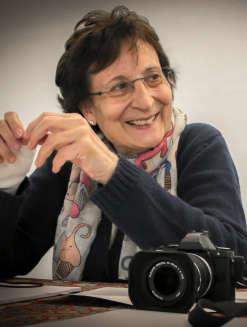
Page 32 | AV News 226 | August 2022
What is your message?
We feel that love can be about the presence of absence. And it can be a powerful overwhelming presence around which an entire life may revolve. Timing the absence of a loved one by not modifying one’s environment is a reminder of a loss for which there is no replacement.
Page 33 | AV News 226 | August 2022





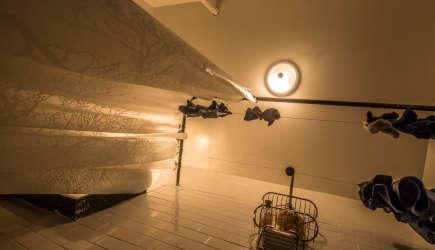


APT 22 continued ...
What plan did you follow when producing it? Who did what?
Carla is a social documentary photographer and has travelled extensively around the world reporting stories such as exorcism practices in India or living conditions in Lima’s barrios. She has also produced story-based AVs in co-operation with a video-maker friend at the time when she was living in Italy. The collaboration ended on her return to the U.S. Francesca has been producing her own AVs for a long time, creating stories and taking the pictures all the while following her inspiration and creativity. Apt 22 was the �rst time they teamed together.
When Carla told her about E.F.’s story, she instantly ‘felt’ it and accepted the challenge. In her role as video maker she chose the images, decided the sequence, the way they interacted with each other, the transitions. She chose the fonts and the music. The way she works, she aims to tell the story but, most importantly, she wants to convey the emotions the story creates.
What were the challenges you faced?
Francesca’s challenge was to work on a story that was very different from the ones she had created before, but she discovered to her great surprise and satisfaction a new and unprecedented narrative vein.
Page 36 | AV News 226 | August 2022
All images courtesy Francesca Gernetti AV-AFI and Carla Fiorina AFI AV-AFI
Did you agree all the time?
Yes, we share a sense of having a common purpose and a great respect for each other’s skills. So we don’t interfere with the other person’s choices. We know they are always thoroughly thought-out and motivated.
What software platform did you use?
APT22 was created using m.obiects.
What next for you?
As a team we have just �nished working on an AV within a theme provided by the Italian FIAF/DIAF department: “Environment, climate, future”. It has been a challenge to work around the story trying to pass on a positive message for the future. We hope we have done a good job.
Below is the link to the English version of APT 22 https://vimeo.com/553103398
Alternatively you scan the QR Code to the right.

Page 37 | AV News 226 | August 2022
Do AVs need a storyline?
Those of you with a long memory will recall the Brown’s Lore page from past editions of AV News. The last one published was in June 1990. At the time of writing, Kate Bush is at number 1 with a record first released in 1995 and this has spurned on the AV News Editor to revive a blast from the past. We hope you enjoy this latest revival.

Jacques van de Weert once made a comment about my entry in an international festival that it was “a typical British documentary”. He re�ected the widely held Continental view of the construction of many AVs from these shores, which was once memorably summed up as “He was born, he lived, he died. So what?”. So I’m still not sure whether Jacques was damning my AV with faint praise or not. Be that as it may, it got me thinking about my own views about what makes a successful production and in particular, whether a narrative structure is necessary or even desirable.
Let’s be clear about the meaning of the word narrative. It is related to, but not the same as narration, i.e. a spoken commentary. The Cambridge Dictionary de�nition of narrative is “ a story, or a description of a series of events”.
Given that the documentary �lm pretty much originated in Britain it’s perhaps not surprising that we have such an af�nity with it. It’s certainly a genre with which we are strongly identi�ed in international AV circles. Of course, documentaries are only one form of narrative production. Storytelling can come in all shapes and sizes.
However simple or complicated, all stories tend to share at least some common attributes. These include a progression of events which build on each other in some understandable way. The power to involve the audience and make them interested in what is happening. And �nally, a conclusion which ties the whole thing together and gives a sense of closure. If you analyse successful AVs from past decades, you’ll �nd that most of them share these features.

Page 38 | AV News 226 | August 2022
Looking around some current international festivals the traditional storytelling format seems to be under pressure from a couple of different directions.
A style of sequence making has developed, particularly on the Continent, which I �nd exciting in some respects and disappointing in others. A lot of these AVs contain fantastic creative ideas and have high production values, which is great to see. But often they appear to reject all three of the requirements for storytelling which I just outlined. What happens in many of them just doesn’t seem to make any sense, at least not to me anyway. Therefore they’re not really engaging because I need to understand the point of the thing or what it’s trying to say to get any genuine satisfaction from viewing it. And frequently they just seem to randomly stop rather than coming to any sort of conclusion.
This lack of understanding is not a language issue because many of these sequences contain no dialogue. AV is a communication medium. If your reaction at the end of a sequence is “well that was very clever, but what was it supposed to be about?” then clearly communication has been replaced by frustration. Brilliant technique or inventiveness on its own is not enough. Or perhaps it is.
The second style of sequence which seems to be wowing the judges takes a different tack. This time it’s taking a single idea, usually a visual one, which may well be quite unusual or interesting and essentially just repeating it over and over again. After about the �rst minute the rest of the AV is pretty much redundant because it never gets anywhere. Again, the sequence just comes to a halt, or perhaps a rather lame ending rather than having a proper conclusion because there is nothing much to wrap up anyway. This time, the viewer’s frustration is largely replaced by boredom.
From the judging perspective, I think it’s important to try to avoid a situation I have seen enacted all too often. That is, being carried away by mere novelty and rewarding it as if it were something truly innovative or inspiring.
Am I being over-sensitive in my reactions to these sorts of productions? Is it that I am just so wedded to one mode of presentation that I can’t appreciate any alternatives in the way other people are seemingly able to? Answers on a postcard please…
If you would like to read the last edition of Brown’s Lore from June 1990, scan the QR Code.

Page 39 | AV News 226 | August 2022
Earth, Trees and Sky

Winner GNAVF New Horizons
Garth Tighe
Ihave always been drawn to wild and lonely environments in search of subjects for my interest in Landscape Photography. Amongst a number of my common elements for creating mood has been, Terrain, Trees and Skies. Earth, Trees and Sky seeks to achieve this.
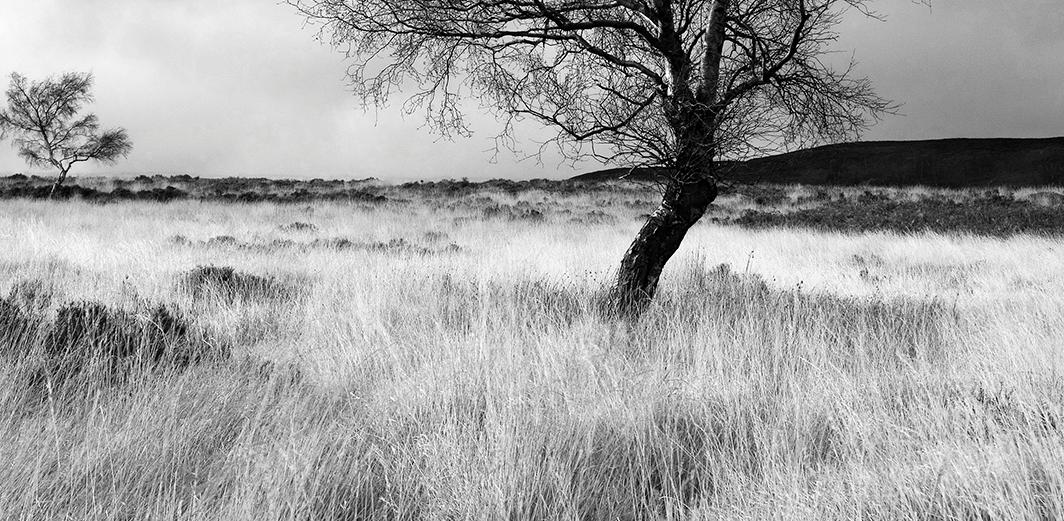
When I �rst heard the music from the �lm, American Beauty, it suggested to me a moody air of melancholy and loneliness. re�ect the gradual changes in the music and mood. It was at this point that I decided to arrange a sequence of my existing images, with long slow fades to the third images produced at the image change, which would further enhance the atmosphere. Monochrome was chosen to continue to develop the mood. A square format was chosen so that original portrait and landscape images could be combined for projection. The chosen images were originally taken in colour and converted to A3 Monochrome prints for entry into other competitions
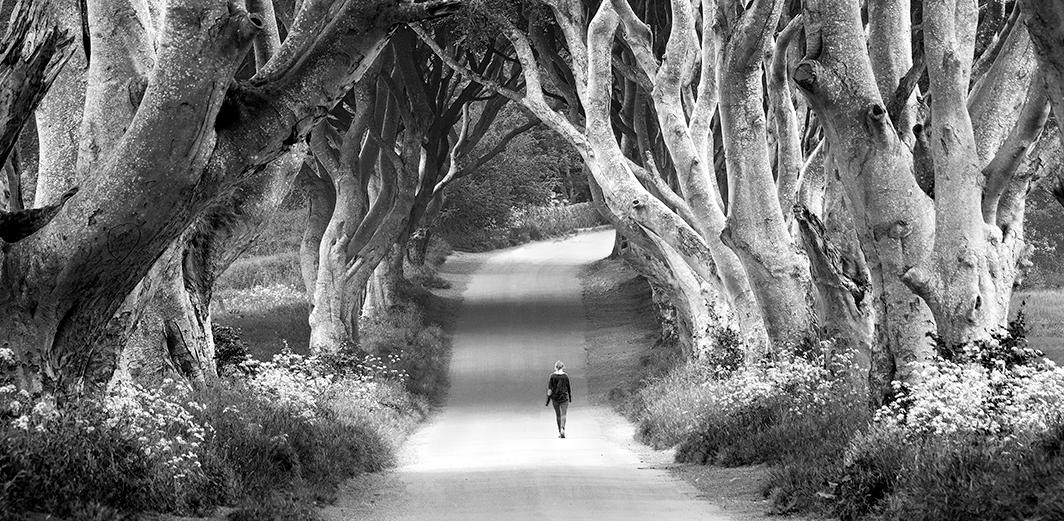

Heavens Above
2nd Place GNAVF New Horizons
Albert Slack
How can something heavier than air �y without self-propulsion or �apping it’s wings?


As a child, I made gliders from paper before making them in balsa and tissue paper which were capable of �ying a reasonable distance. I joined the Air Training Corps with the hope of getting my glider wings but education, articles and marriage put an end to that idea.

I saw an AV featuring a glider which impressed me but it lacked a story. Researching a subject is often overlooked by AV producers but it can be enjoyable and fascinating, not to say time consuming. I realised I was bordering at being overweight to be a passenger in a glider and clubs do not allow cameras and equipment in the cockpit because they could shatter the canopy and the repair costs thousands even assuming pilot and passenger both survived.
Eventually, I found the York Gliding Club in my research and they were extremely helpful and accommodating. I also made trips to Great Hucklow when they had a vintage day, to Elvington Air�eld to research George Cayley and to Brompton where speaking to a local, she had shared her bedroom with Sir Richard Branson!
With the encouragement from Jill and John at Wilmslow, the sequence was produced and I hope it speaks for itself. I tried to follow the established format of beginning, middle and end in the script, as well as being serious but with a touch of humour to keep the audience awake.

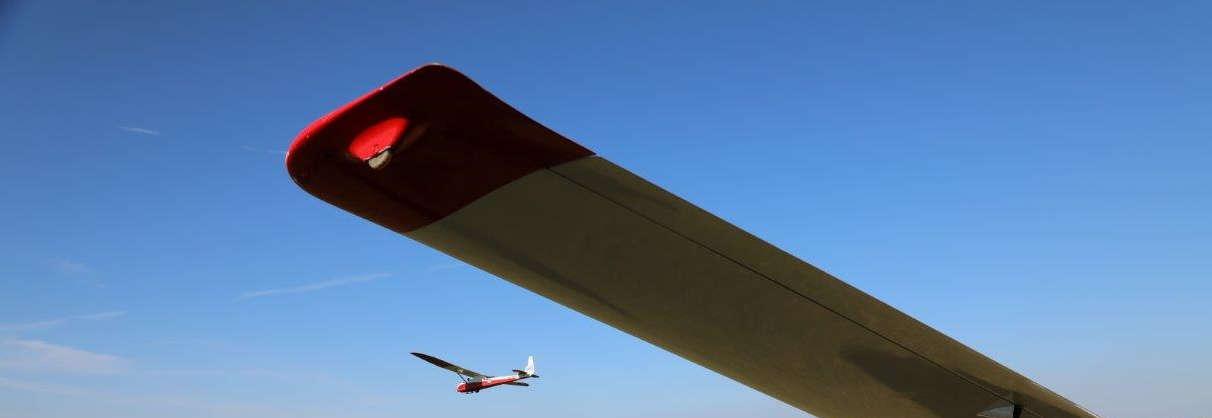


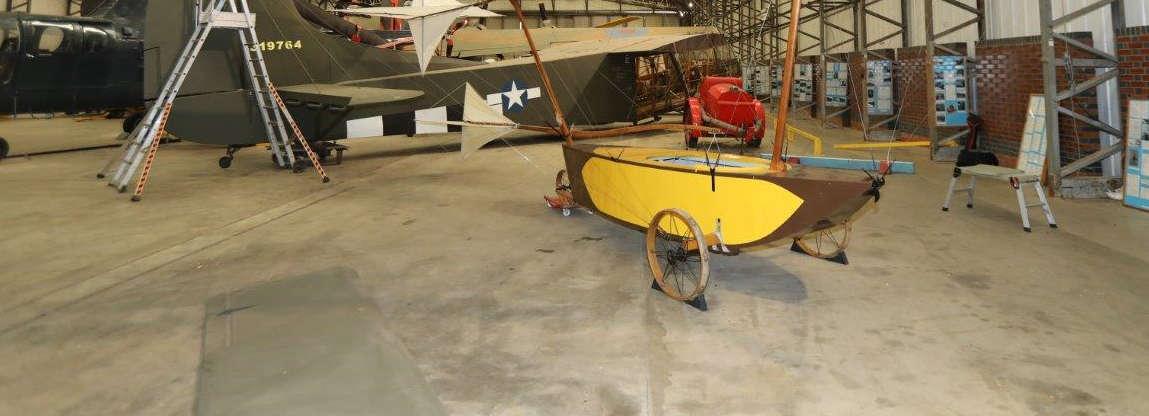
Richard. Rick. Ricky
3rd Place GNAVF New Horizons
Dave Thompson
Ihave wanted to tell the story of my older brother Ricky (and the best man at my wedding) for a while now, but it was only following lockdown and my 30-day trial of PTE in 2021 did I feel I had found at last the best process to both show and speak about his life.
It was while I was putting the story together and seeking details of his life, which although so much was not used in the �nished production, they all helped me greatly in putting the AV together and also helped in the way the audio was toned and the story was told.
My mother’s records stated that Ricky was born in hospital, and he was so ill at birth that he was not expected to live and quickly a minister was brought along to bless him at the birthing bedside.
This simple statement got me thinking. The NHS was not formed until almost a year later (June 1948) and I wondered at the “cost” of being in hospital in 1947. Something my generation cannot comprehend.
My older sister was of immense help on family history. I soon found that I wish I had asked more questions and talked to my parents more when they were alive. I lost track of the times. I thanked my mother for writing family information down and my Dad, who used his old Box Brownie camera to record in photography so much of my family’s early life.
I knew that Ricky was born with a hole in his heart but did not know that in 1948 this was major surgery and from records I now believe that Ricky may be the third person in the whole country (and probably the youngest) to have this major operation which could only be performed by senior surgeons and in a London hospital.
While researching for my AV it hit me that we take so many serious health issues for granted, without a thought of the risks (nor expense) of these procedures. We now take “keyhole surgery” as the norm without leaving a mark, yet Ricky had a two inch thick scar, which started in the centre of his chest and ended directly over his spine.
Page 44 | AV News 226 | August 2022
The early family photograph of Rick in a London hospital, taken at Christmas, was severely damaged, it was only while attempting to repair it, for my AV, that I noticed the thick lines under Ricks eyes and how thin he looked. For me it shows the power of a photograph and it says more of his illness and poor health than any words could.


Grimsby Docks and life at sea
Thankfully my parents took and kept many family photographs. As family members left us, they were handed down to me to save and preserve for future family members.

I needed a few images of life on Grimsby docks during Ricks life, thankfully “The Great Grimsby Fishing Heritage” has a few photographs in public domain that helped present the dangerous and dif�cult life of deep-sea �shing.
Through this I also made contact with many who knew and sailed with Ricky, and I learnt more of his life that I previously did not know, which all helped in the formatting of the AV.
Page 45 | AV News 226 | August 2022
Richard. Ricky. Rick continued ...
I included a small clip of video of a trawler breaking through rough seas mainly as I feel it showed the dangers of life at sea �shing the North sea far better than my words could.
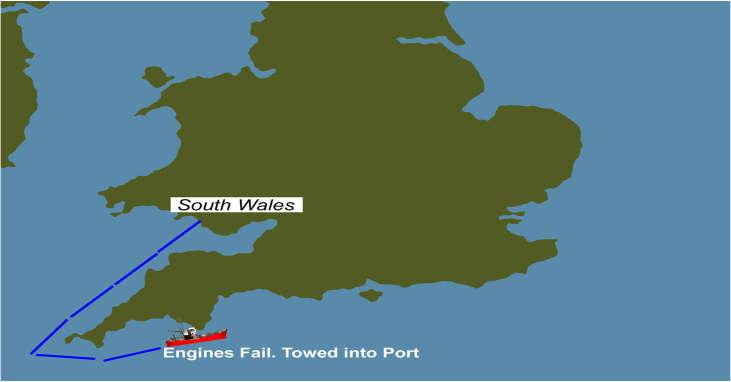
The Hull lifeboat captain who went to The First Chance aid in 1983 contacted me. Even now he recalls how sadly they were seconds away from rescuing the crew when it disappeared and although they searched, they failed. Strangely this brave man’s story helped me get through the (at times) dif�cult parts of the audio sections of when the boat was lost.

The story is of Ricks journey from birth, to school, to him working on the docks, and then going to sea are all from my family’s history. Our uncle Richard (who sponsored Rick on his early trips as a cabin boy) did loose half of his right arm in the ships winch and even now I still cannot think of how he coped while they kept the damaged arm in ice as the trawler took three days sailing before he could be hospitalised in Norway
I tried to tell Ricky’s life, from his dif�cult lifethreatening birth, and how he grew into the man he became. The life of many local men who went to sea and then the loss of a way of life in Grimsby. The saying by Vincent Van Gogh I found while researching for my AV, for me, sums up the lives of �shermen all over the world and felt it made an important statement make near the ending of my AV.
Page 46 | AV News 226 | August 2022
The Title
For competitions, I was advised not to make an AV title obvious. This made me rethink a lot of what I did when it comes to how I present an AV once it is �nished. With Richard, Rick, Ricky, It made me recall that it was only my mother who ever called him “Richard” and when she did, we all knew she was not happy. When younger, he was “Rick” to us all. It was only when we meet others (school , work, in the pub or his friends) that we heard them only ever call him “Ricky”.
I feel the title of “ Richard, Rick, Ricky ” explains his life from birth until his sad end.
We called �shermen “3-day millionaires” which was their normal time at home in-between �shing trips.
They relied on the market prices and at many times they came home from weeks �shing in the cold artic waters only to be in debt (they’d spent more in the ships bond than they earnt) but then most times they had so much money, they spent like millionaires with no thought of tomorrow.
I never went to sea myself (I could never get my head around why people did) but after my researching into the life of Grimsby �shermen for my AV, I wondered if they lived life as much as possible in their short time ashore, in case it was their last.

When I found the aerial view of the empty Grimsby dock it shocked me of the loss. In my youth it was always like the image I used to title the AV. The docks were always and stacked out with trawlers; the river Humber was always full of trawlers waiting for the high tide to allow them to either enter or leave the Grimsby dock area. The two photographs for me say more than words on the changes we have lived through.

Page 47 | AV News 226 | August 2022
Richard. Ricky. Rick continued ...
Ending the AV
I found it dif�cult to decide how best to end my AV on Ricky’s life. It must have changed so much over time. I struggled (and to tell the truth, I cried at the memory) with how to conclude the �nal statement on my older brother Ricky’s life. After so many failures, I realized that he was never happier than when he was at sea. Knowing him has I did, I felt he would not like, nor cope, with the current loss of sea �shing from Grimsby.
I could only think that he came into the world �ghting for his life and left the same way. I feel he left doing the one thing he loved the most, being a Grimsby �sherman.

It may sound strange, but I found myself pleased that he did not become just another sad old drunken �sherman and struggling to come to terms of a life without the sea.
Conclusion
Despite Covid. I am pleased that 2021 gave me the time to investigate PTE and then purchase it.
During lock down our small group of local AV enthusiasts meet regularly via Zoom and their support and banter helped me throughout the process of production in the telling of Rick’s story. It is great to have great AV friends who do not mind helping when things get dif�cult.
I found the making of the AV of Richard, Rick, Ricky along with sharing his story with so many (via the RPS competition) not only helped me put to bed the sad loss of a much missed older brother, it also allowed me to record an important part of my family history for the next generation and in a format that they may better understand of a way of life now gone.

Page 48 | AV News 226 | August 2022
My Dad’s Story
Highly Commended GNAVF New Horizons
Shirley Hollis ARPS AFIAP
My dad was an active, hard working and much loved member of his family and community; having devoted his life to the voluntary service of others in so many ways. However, somewhere between the ages of 75-80 years old, it’s dif�cult to be exact, his memory and reasoning began to diminish as dementia took hold. With his full knowledge and agreement I continued to take photographs of him as I persisted in my attempts to record everyday family events.

As dad’s dementia developed much of his memory and ability was lost but he retained many elements of his personality, his love of family, although towards the end he had no idea who we were, his gentleness and his very strong gentlemanly approach to all he did. Mum and dad remained devoted to each other until the very end.
The AV I created was an attempt to depict this season in my father’s life with dignity and honesty; demonstrating the devotion and love Mum had for him throughout, whilst also showing the devastating impact of dementia. The music, Four Notes: Paul’s Tune, was chosen for its relevance to the subject of the AV. It had been written by a gentleman living with dementia, much of his story resonated with me and showed how it is possible, with the support of loved ones, for those with dementia to retain and enjoy elements of their earlier lives.

Page 49 | AV News 226 | August 2022
Guardians of Winter

Commended GNAVF New Horizons
 Mike Pill ARPS
Mike Pill ARPS
The AV was originally developed from an idea of how to show some of my winter images in an AV and on a local walk during lockdown I noticed that many of the branches of the trees in winter looked like hands reaching up into the sky. It was from this idea that I developed a simple story, a poem really, that the trees were the guardians of winter, protecting winter, her snow, her frost and ice etc. until such time as Spring took over and the cycle eventually repeated itself.
I also wanted to bring in some metaphors into my story - the idea of red berries being like blood as part of the process of birth. I also added quite a few subtle and not so subtle sound effects to reinforce the mood of my words - wind noise, bird song etc.
The music sound track also used several short pieces from Eric Matyas's excellent website www.soundimage.org.

Page 50 | AV News 226 | August 2022
Distinctions Successes
Warmest congratulations to the following AV workers

Adjudicators
Robert Albright FRPS
Howard Bagshaw MPAGB/AV ARPS
Martin Fry FRPS EFIAP/g AV-EFIAP/b APAGB
Gordon Jenkins HonPAGB
Richard Speirs DPAGB BPE2 APAGB
Hosted and organised on behalf of the PAGB by Ian Bateman MPAGB
FRPS AV-AFIAP APAGB
Page 51 | AV News 226 | August 2022
Celebrating Mark Allen MPAGB/AV
With thanks and appreciation to Rod Wheelans
MPAGB MFIAP FRPS FIPF HonPAGB HonSPF
The first MPAGB/AV was awarded in 1999 and there have been only 23 Applications in total, with just 10 being successful. The latest MPAGB/AV was awarded on 15 May 2022 to Mark Allen, from Catchlight C.C. in Northern Ireland.
As a PAGB AV Advisor for C and D, I knew I needed help and I knew how valuable the PAGB Advisory service is. I went through the of�cial PAGB Advisor route and worked tirelessly with my mentor. For ‘M’ you have to submit at least 3 shows with a running time of 15-20 minutes and it has been described as “not quite impossible”. I feel that my �rst show is the weakest, Photographer's Paradise, features iconic Icelandic landscapes with whambam music for the �rst half and some relaxing piano for the second half.
I think that my second show is my strongest, All Human Beings. It uses iPhone images from the Oscar Schindler Museum and Auschwitz. I used a harsh high contrast Look Up Table for the �rst half and a more sepia-toned LUT for the second half. The change occurs with a change in the music and is subtle. The music is dramatically supported by actual victim testimony.
My �nal show was a bit of a risk. A Landscape of Love is a new show, untested in competition, with, I think, a lovely story about life, love and loss, set against the dramatic landscapes of Yellowstone. It includes a visual impression of the Sword of Damocles to imply impending death, which is followed by ten seconds of silence.
The full playlist is on YouTube, see the QR code on the opposite page.

How to take your Audio Visuals to the next level
In a previous edition of AV News, Mark Allen kindly produced an article on “How to take your Audio Visuals to the next level”. The article has been updated and is available on-line. Click in the QR Code to the left to view.
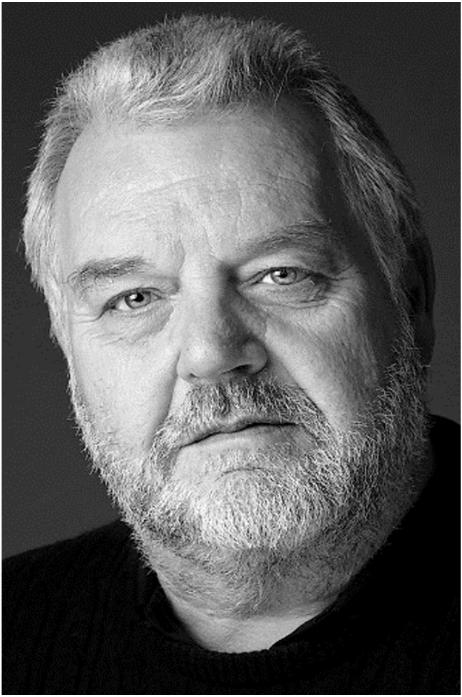
Page 52 | AV News 226 | August 2022
Above: From Photographer's Paradise


Right: From All Human Beings
Right Lower: From A Landscape of Love







RPS Distinctions Advisory Day
Edgar Gibbs FRPS, MPAGB, AV-AFIAP

Audio Visual is a medium/art form that has been in my life since the early 1980s. One thing I have continued to try and keep alive is the Audio Visual Distinction that Sir George Pollock instigated over 50 years ago, even though it now comes under Film Digital and Multimedia.
Following on from the Advisory Day that Martin Fry organised some years ago in the Cotswolds, the AV Group Committee decided to hold another one. This one would be different as it would be both in person and via Zoom. It would need a suitable venue and was an ideal opportunity to use the Tony Troman Theatre in RPS House which was supported by Evan Dawson the Chief Executive.
There was quite a complex unit which was controlled by Sheila Haycox and a laptop at the lectern which Ian and I were in charge of. At the practice stage, Linda had joined Zoom from the foyer so we would know what the Zoom audience could see and hear.

Tony Troman would have been impressed with AV in "his" theatre using top quality speakers and a 4K projector with a large screen.

We had three participants, the �rst being Jim Waddington who had travelled all the way from Milton Keynes to be there in person. Ian Bateman, Richard Brown and Howard Bagshaw gave some excellent comments, and talking to Jim afterwards he was pleased with how it had gone. The second participant was Tim Harvey who joined using Zoom.
We then had a slightly extended coffee break and the �nished with the AV from the third participant Dilip de Sarker who had booked to join with Zoom who was unfortunately unable to join us.



Did we learn from this experience-yes
Are there elements we can improve - yes.
Will we hold another Advisory Day - yes.
My thanks to Ian Bateman, Richard Brown, Howard Bagshaw, Sheila Haycox, Martin Addison and all those that contributed either by submitting, commenting or just watching which made it a good morning for everyone. Thanks also to Matt Steele from RPS House for his technical support.
All photographs courtesy Howard Bagshaw
I’ve recently had the pleasurable task of chairing several judging panels for Audio Visual competitions. This has, so to speak, put me on the other side of the fence. I’ve had moderate success with some of my own sequences from time to time, in Regional, National and International events and consequently I’m very aware of how much success in a competition can mean.
Each entry that I and my fellow panelists watch represents considerable creative effort, and needs to be treated with respect. Egos are as fragile as eggs, and a disappointed entrant may well not enter again, or indeed stop making AVs – not at all the object of the exercise. So all our judgements must be kindly – tact and sound advice can be combined, and the aim must be always to foster creativity, not to score points over a �rst-timer’s errors.
So, the �rst criterion to apply is – has the author achieved what he or she set out to do? To tell a story very possibly, or portray some aspect of something –express an idea, or simply describe the beauty (or indeed ugliness) of a place, a person or an object.

One of the commonest causes for the judges’ disapproval is a sequence that is over-long, and because of this, wanders from the point. The story or the idea – the raison d’être should always be in the forefront of the author’s mind. Anything that doesn’t help the telling of that particular tale should not be there. There may be a couple of causes for this problem. One is being straitjacketed by a piece of music. It is of course always good to exploit the natural ending of a score, rather than just fading it out, or worse still stopping it in mid-beat, and so if a single unedited piece is chosen, it can be dif�cult to �nd the pictures to �ll the whole thing. This leads to padding with second-rate and irrelevant pictures, and a phenomenon often described as ‘IBM’ –Imprisoned By the Music.
My personal maxim of many years now has been ‘Pick the Best and Bin the Rest’. Audio Visual is de�nitely not a way of using up second-rate pictures that you wouldn’t dream of putting into a print competition. If the music is too long you need to �nd a way of editing it down to the right length for your purpose.

Page 56 | AV News 226 | August 2022
Another, perhaps the opposite, cause is a surplus of good pictures. “I must include that – it’s a really nice shot”. But is it relevant? Does it serve the story – help your objective? If it doesn’t, it probably belongs in another sequence! Next, the presentation of your piece is important. Poor sound can damage an otherwise good work – background noise, sudden changes in level, over-loud music or sound effects under speech, all these are things to watch for and avoid. The received wisdom is that good headphones are able to give you the detail, while loudspeakers convey the broad picture more effectively. Use both.

I have a few strongly-held personal views, some of which it seems I am becoming known for. One is the quality of the graphic design content of your piece. This may well be just the main titles and the end credit, or something much more – maps, diagrams and subtitles for instance. A thoughtful and original choice of font, colour, size and placing of any type matter is something often not consciously observed by the viewer, but it is still noticed subliminally, and at its best the main title can set the scene for the whole thing before we see any pictures at all. It gives your story a head start!

Another of my personal crusades is the writing and delivery of a script. I’m delighted that the MCPF have recently accepted my gift of a trophy intended to foster just this aspect of the medium in the MidPhot annual AV competition.
The accompanying illustrations are taken from Alan and Bev Tyrer’s Nameless, the story of a sad little Victorian headstone to an unnamed new-born child. It represents a �ne example of the what judges will seek, and as such it won First at this year’s MidPhot competition, as well as the Audience Vote, and also the Award for Excellence, a new MidPhot award aimed especially at fostering the skills of writing and delivering narration.
In My View – A Judge’ s Perspective continued ...
A well-written script is a great asset – words that �ow easily and compliment the images. The spoken word can often help to make sense of disparate images. Watch the TV news with the sound turned down if you don’t believe this – it may well not make complete sense until you can hear the presenter’s voice. A good script can be the string on which to thread some very disparate beads, creating a beautiful and comprehensible whole.
Delivering those words is not easy, but it is worth the effort of getting it right. So many voice-overs sound as if they are being read, not spoken. We need the illusion that the narrator is speaking directly to us, explaining and enlightening, not just reading from a piece of paper. One of the things that spoil many a narrated sequence is the leaving of pauses in the wrong place –a jerky delivery which at worst makes nonsense of a perfectly well-written sentence.

Just as certain fonts will help set a particular theme, so will certain voices add to the authenticity of a work. Male or female, cultured or ‘ordinary’, softly spoken or harsh, regional and foreign accents, all these help give a particular character to the story. If you don’t like the sound of your own voice (and many feel awkward at hearing themselves, even nowadays) get someone else to do it. Friends may be �attered to help (or they may need coercion!), and there are people around who will do good polished voice-overs for you for a modest consideration – Fiverr on the web offers quite a bit of choice for instance. But do be objective about your own voice – it may be just right for what you are currently doing – don’t discount it just because you are embarrassed by the way you think you sound.

Music Licences
Ian Bateman FRPS APAGB AV-AFIAP MPAGB

As photographers, most of us are familiar with the techniques of taking and editing images, but the audio side has always presented a different set of problems. I’m glad to see that Malcolm Imhoff, in the new Sound Hunters section of AV News, in the last issue covered the basics of the IAC Music Copyright Clearance Scheme.
Some AV makers have the musical talent to compose and record their own music – notably Judith Kimber in recent years, but also several others in the past. Most of us are unable to do this however, so have to use commercial music in some form in our productions.
Malcolm’s article last month described the licences needed to use commercially available music, two of which – the MCPS and PBI licences are available to purchase from the IAC if you are an IAC member, and RPS member, or a member of a PAGB af�liated camera club. The vast majority of camera clubs in the UK are members of one of the PAGB Regions (WCPF, CACC, L&CPU etc etc), so the scheme is readily available for a very low price as explained in the article.
There is a third licence, the PPL (Public Performance Licence), which is available to IAC members only, that covers the playback of licenced music in a non-licenced public hall. This one is the cheapest of the three (just 63p), but has caused the most confusion over many years.
The key consideration is that it’s only required if the venue doesn’t have its own music licence. Up until a few years ago, there were two competing schemes for licencing music playback – the PPL licence needed by the ‘performers’ and the PRS licence needed by the venues. Some time ago though, the companies merged into “PPL/PRS”, and now issue a joint licence called “The Music Licence”.
Page 59 | AV News 226 | August 2022
Music Licenses continued...
It’s fair to say that pretty much every public hall that you will encounter will already have its own licence, making the need for your own PPL licence redundant. As a check, Robert Albright asked the PPL/PRS for clari�cation last year, and the response was:
Hi Robert,
Thank you for getting in touch with us!
As discussed, if a venue you are showcasing your work in already has a PPL PRS licence which covers them for copyright music, you would not need an individual licence for yourself as royalties are already being accounted for by that premises.
Any questions please let me know.
Shannelle O’Hagan
SME Music Licensing Adviser
Occasionally you might �nd yourself doing a talk in an unusual venue (I once did one in a gym…) where the licence is not present, so for a ‘belt-andbraces’ approach the PPL licence is still worth getting, especially as a year’s membership of the IAC is only about £30 more than the cost of the licences anyway.
To Credit or not to Credit?
A peculiarity of the IAC licences is that the name of the performing artist must not be credited in the AV sequence, though the name of the piece of music can be (though this is not mandatory).
If you choose to use ‘Royalty-Free’ music however, the source of the music are usually a requirement of the licence. There are numerous companies and websites providing royalty-free music (note – not ‘Copyright-Free’, you are buying a licence to waive the royalties), and they each have their own requirements.
A rapidly expanding area is the concept of Creative Commons music licences. Under this scheme, an artist freely publishes music for public use in the hope that their music will eventually become better known.
There are several types of Creative Commons licence, but most have the conditions shown in the table overleaf:
Page 60 | AV News 226 | August 2022
You are free to:
Share copy and redistribute the material in any medium or format
Adapt remix, transform, and build upon the material
for any purpose, even commercially.
Under the following terms:
Attribution You must give appropriate credit, provide a link to the license, and indicate if changes were made. You may do so in any reasonable manner, but not in any way that suggests the licensor endorses you or your use.
This concept has been adopted by YouTube, and there is a whole section on YouTube’s website now dedicated to Creative Commons music, so this is becoming a useful resource when searching for music. I’m sure that you will have noticed the variation or absence of music credits at the end of AV sequences – it all depends on the source of the music used.
oooOOOooo
IPF 39th National AV Championships
Lilian Webb AIPF ARPS
The IPF AV Group Committee are happy to announce that in conjunction with the Irish Photographic Federation, the 39th National AV Championships and 8th International AV Competition will be held on 15th & 16th October 2022 (two days provisionally!) via Zoom.
We are honoured to have as our judges Ian Bateman, FRPS, MPAGB, AVAFIAP, APAGB (who has judged previously), and for the �rst time Sheila Haycox, ARPS, MPAGB/AV, EFIAP. The sequences will be forwarded to them in advance. As usual the National entries will be commented on, but not the International entries. Put the dates in your diary NOW! We look forward to receiving your entries.
Further details from Lilian Web at: ipfavgroup@gmail.com
Click on the QR Code to download Entry Form and Rules.

Page 61 | AV News 226 | August 2022
DaVinci Resolve – Video Editor Overview
 Keith Scott FRPS DPAGB AV -AFIAP
Keith Scott FRPS DPAGB AV -AFIAP


For many years, my contributions to AV News have mostly concentrated on Adobe Photoshop, an incredibly powerful industry standard image editing software program which also contains a basic video editor. However, with ever-increasing amounts of video clips being used in AV sequences, I thought it was time to explore the availability and suitability of speci�cally dedicated video editing software.
Most of us will already have simple video editing software on our computer. Both Windows and MAC operating systems, install a basic video editor by default, which may or may not be suf�cient for our needs, this will of course depend on the amount and complexity of video editing envisaged. For those video clips that are only a few seconds long running within a Pictures to Exe AV sequence they may be suf�cient, however for those who wish to be more adventurous, or perhaps make feature length videos, then such editing programs are probably far from adequate.
A Google search of the internet for ‘video editing software’ produces a surprising result, the number of programs available is bewildering. Con�ning the search to ‘Free Video Editing Software’ still produces a large number, some names being familiar and expected, whilst others I’ve never heard of. However, one name stands out for several reasons, “Blackmagic Design DaVinci Resolve”. This software is available in two distinct versions, “DaVinci Resolve 17” which is free to use, described as Hollywood’s most popular solution for editing, visual effects, motion graphics, colour correction and audio postproduction. All in a single software tool for Mac, Windows, and Linux! This version contains most functions of its bigger brother “DaVinci Resolve Studio 17” which is a paid version (at time of writing costs £225).
This full studio version has everything in the free version plus the DaVinci Neural Engine, stereoscopic 3D tools, dozens of extra Resolve FX �lters, and Fairlight FX audio plugins, plus advanced HDR grading and HDR scopes.
Page 62 | AV News 226 | August 2022
This is a very comprehensive package.
Both versions of the software can be downloaded from the Blackmagic Design website after completing a simple registration form.


Before downloading and installing DaVinci Resolve you should check the system technical requirements to ensure your computer can run this software, and that it has suf�cient storage capacity. Installation alone requires around 2.4 GB of hard disk space, additionally �le storage for the video clips, sound �les, special effects etc, plus the rendered �nal video can occupy huge amounts of hard disk space. System requirements are not listed in this article, they are listed at the following website, please read them carefully before installing.
https://motionarray.com/learn/davinci-resolve/davinci-resolve/systemrequirements/?msclkid=06315312b4fa11ec9b68d5ec5fd8f110


Page 63 | AV News 226 | August 2022
According to the instruction manual, which is a 159 MB pdf �le consisting of 3625 pages; DaVinci Resolve integrates editing, compositing and motion graphics, colour correction, audio recording, mixing, and �nishing within a single, easy to learn application. Editing, compositing, grading, and audio tools found in DaVinci Resolve should be familiar to experienced operatives who have used other video applications, they are also suf�ciently friendly to people new to video editing.
When launching the program, the �rst thing to appear is the “Project Manager” pictured left. This is where you control the storage and locations of your various video projects. it will of course contain no projects initially until you create and store your own.

Once you open a project, you have the option of adjusting the System and User Preferences and the Project Settings governing the currently open project. When you �rst install DaVinci Resolve, the most important settings are selected via the installers on board questions. However, if you are opening DaVinci Resolve for the �rst time, you should check these settings to make sure they are optimized for your system. There are individual preferences and settings for each account on a given computer. This means that multiple users can each have their own login, and DaVinci Resolve will maintain separate workspace layouts and preference for each user. The preferences panels, lets you set up the overall environment of your DaVinci computer or workstation, choose the hardware to use and user interface settings you prefer.

This �oating “Project Manager” can be moved around, reduced, or enlarged in size simply by clicking and dragging any corner. It can be as small as you wish, or if you have lots of projects on the go you can �ll your computer screen to see them all. The three main control buttons are self-explanatory i.e., New Project, New Folder, or Open. Everything about the “Project Manager” is simple to use and fool proof. Double clicking on a project will automatically open the project into the “Cut” fast editing page.

Page 64 | AV News 226 | August 2022
DaVinci Resolve has two different editing pages, entitled “Cut” and “Edit”, these are intended for different type of operatives or work rates. While the “Cut” and “Edit” pages both share many of the same panels such as the Media Pool, Timeline, and Viewer, the controls that are exposed on the “Cut” page have been designed for speed, so you can cut video programs faster. The default workspace of the “Cut” page consists of the Media Pool, a single Viewer, and the Timeline area. These three regions let you quickly import and organize clips, edit clips, and even export the result, all from within the Cut page.

The comprehensive “Edit” page, pictured below, contains every editing tool you need for creative editing through �nishing. The “Edit” page is divided into three main regions: the media source browser found at the top left, the video Timeline Viewer at the top right, and the Timeline at the bottom, all of which work together to let you import, edit, and trim timelines with a �exible variety of tools and methods. Also shown in this image is the “Inspector Panel” at top right corner.
The Inspector can be opened to let you customize compositing, transform, and cropping parameters for clips, as well as clip-speci�c retime and scaling options. Furthermore, the Inspector lets you edit the parameters of transitions, titles, and generators used in the Timeline, in order to customize their effect. When the Inspector is open, the Source and Timeline viewers move to the left, to sit alongside the Inspector showing the selected clip parameters. However, if your computer display resolution is not high enough, opening the Inspector may result in the Media Source Viewer being hidden.

Page 65 | AV News 226 | August 2022
Each function of DaVinci Resolve 17 has its own dedicated control page, access to each page is via a series of buttons located at the bottom of the screen
From left to right these buttons are entitled;
Media: This accesses the “Media Pool” where media such as video clips, music, sound effects, etc can be imported.
Cut: This loads the fast-editing page for speedy working.
Edit: Where far more editing tools are available, tools within this page will be familiar to many.
Fusion: Gives access to special effects, perhaps best described as being like using “Adobe Premiere” followed by “Adobe After Effects”, albeit in this instance the special effects are all built into one main DaVinci program.

Colour (Color): Gives access to an amazing set of colour grading controls, more about those later.
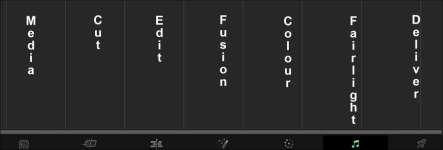
Fairlight: This has nothing to do with light or images but is all about audio editing (see image below) Just like all pages the layout of the Fairlight audio editing page can be con�gured to your own preferences. Fairlight Audio Core engine allows for simultaneous playback of up to 1,000 tracks with no additional hardware!

Page 66 | AV News 226 | August 2022
Deliver: This opens the page where the output of the �nal rendered video is controlled and produced. Due to space, we won’t look at rendering in this issue.
Pressing the “Color” button gives access to a huge amount of �ne control of hue, saturation, and luminance of your edited videos prior to rendering. The four colour wheels can be changed from Primaries which controls ‘Lift’, ‘Gamma’, ‘Gain’, and ‘Offset’, to High Dynamic Range which controls ‘Dark’, ‘Shadow’, ‘Light’, and ‘Global’ at the click of a mouse.
DaVinci Resolve includes every video editing tool you could possibly need, and the “free” version is exceptionally well priced. Even the paid for version is a fair one-off price when compared to other professional video editing software paid on monthly subscriptions.

Question is this software over the top for most AV workers? yes absolutely. However, if you want to be armed with a huge variety of high-quality editing tools you would be hard pressed indeed to �nd anything anywhere better, at any price. Are there any drawbacks? Yes, this software requires a long learning curve to fully master. There are however plenty of good tuition videos to learn from, many of which are included in the “help menu”. There are also many videos on YouTube providing excellent tuition. Is there anything I didn’t like about this software? Yes, I was unable to change the working environment to a lighter colour, perhaps a mid-grey which would have made reproduction in our magazine pages clearer.

Page 67 | AV News 226 | August 2022
Email: avmakerssouthafrica@gmail.com
Registration will open on 1st October 2022 and will close on 29th October 2022. Results will be announced on or before 16th December 2022, and emailed to authors on the same day.
The smashing logo was designed by Andrew Gagg FRPS


Page 68 | AV News 226 | August 2022 The RPS AV Group Committee Chairman Edgar Gibbs edgar.gibbs@ntlworld.com 029 2056 4850 Vice Chairman Ian Bateman ian@ibateman.co.uk 01395 901028 Secretary Keith Watson k.n.watson@virginmedia.com 07713 918521 Treasurer Alastair Taylor alast.taylor@gmail.com 01952 550398 Sheila Haycox sah2@live.co.uk 07709254856 Andrew Gagg gagg@gagg.f2s.com 01905 748515 Martin Addison martin@mrafoto.plus.com 07837 942260 Peter Warner peter@peterwarner.co.uk 07811 953480 Salon
AV-AFIAP AFIAP LRPS AV-DPSSA APSSA
Director: Jeff Morris
Publication Information
AV News is published three times a year by the AV Group of the Royal Photographic Society. It is distributed free to Group members and is available to others for an Annual Subscription of £22 in the UK, £25 in Europe and £27 elsewhere – contact Alastair Taylor at avtreasurer@rps.org
Copy Deadlines
23rd February 1st April
23rd June 1st August
23rd October 1st December
Please note that the copy deadlines are the absolute latest. To ensure publication in the next issue please send copy as early as possible. Publication date may vary according to the dates of National and International AV events.
Any items concerning Audio Visual and Multimedia are welcome, including reviews, technical details, events, photographs, letters and queries. All contributions should be submitted to the Editor at: magazine@avnews.org.uk

The views expressed are solely those of the contributor and not necessarily those of either the Editors or the RPS AV Group.
Distribution: AV News is forwarded to RPS AV Group members using the labels produced by the RPS Membership Department in Bristol. Any member not receiving their copy should contact Bristol. However, the Secretary will be pleased to post single copies to those members who have failed to receive them.
Copyright: All rights reserved. No part of this publication may be reproduced, stored in a retrieval system or transmitted in any form or by any means without prior permission of the copyright holder.
Printed By Mensa Printers, Arundel Lane, Shef�eld. S1 4RF magazine@avnews.org.uk
Planned Publication Dates
JOIN ONLINE www.rps.org OR CALL 0117 316 4460 Standard £122 Family £184 Overseas (under 65s) £110 65 and Over £92 25 and Under £56 Student £56 Disabled £56 Life (from) £POA
Subscriptions
Annual

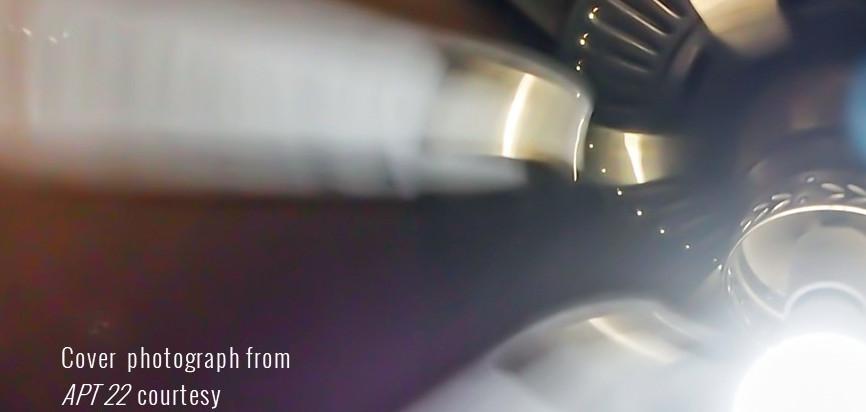


































 A Tribute from Howard Bagshaw ARPS,MPAGB
Image of Lise, from Beeswing
A Tribute from Howard Bagshaw ARPS,MPAGB
Image of Lise, from Beeswing





 EFIAP FIAPF
EFIAP FIAPF




























 Jenny Gee LRPS, DPAGB/AV and Malcolm Gee ARPS, DPAGB/AV
Jenny Gee LRPS, DPAGB/AV and Malcolm Gee ARPS, DPAGB/AV





 Left, top to bottom: Richard Jefferies, Des King, Alan Horn, David Portwain, David Collins.
Left, top to bottom: Richard Jefferies, Des King, Alan Horn, David Portwain, David Collins.

























































 Mike Pill ARPS
Mike Pill ARPS


























 Keith Scott FRPS DPAGB AV -AFIAP
Keith Scott FRPS DPAGB AV -AFIAP





















